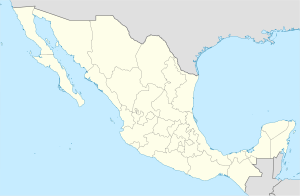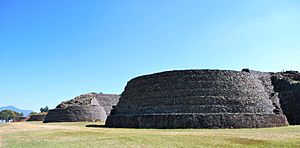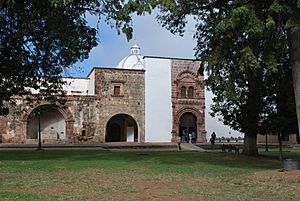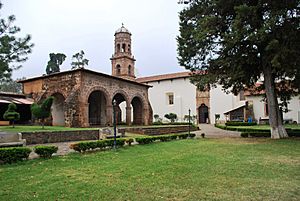Tzintzuntzan, Michoacán facts for kids
Quick facts for kids
Tzintzuntzan
|
|
|---|---|
|
Town
|
|
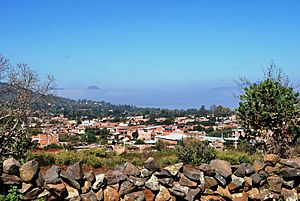
View of the modern town from the archeological site
|
|
| Country | |
| State | Michoacán |
| Founded | 12th century |
| Municipal Status | 1930 |
| Area | |
| • Total | 165.15 km2 (63.76 sq mi) |
| Elevation
(of seat)
|
2,050 m (6,730 ft) |
| Population
(2005) Municipality
|
|
| • Total | 12,259 |
| • Seat | 3,252 |
| Time zone | UTC-6 (Central (US Central)) |
| • Summer (DST) | UTC-5 (Central) |
Tzintzuntzan (Spanish pronunciation: [tsin'tsuntsan]) is a town in the state of Michoacán, Mexico. It is located on the northeast shore of Lake Pátzcuaro. The town is about 53 km from Morelia, the state capital. It is also 17.5 km from Pátzcuaro.
Tzintzuntzan was once the capital of the powerful Tarascan state. This was before the Spanish arrived in the 1520s. Today, it is a smaller town. Its main attractions are an ancient archeological site and a historic monastery. The area also has another important archeological site called Ihuatzio. Tzintzuntzan is famous for its lively festivals. These include the Festival of Señor del Rescate and Day of the Dead celebrations.
Contents
History of Tzintzuntzan
The name Tzintzuntzan comes from the Purépecha language. It means "place of the hummingbirds". The Purépecha people had a god named Tzintzuuquixu. This name means "hummingbird of the south". This god helped guide the tribe to the Lake Pátzcuaro area.
The Purépecha Empire
The Purépecha were one of the tribes that came to the Pátzcuaro Lake area. This happened in the 12th century. From the 12th to the 14th century, the Purépecha became very strong. Their capital city was Tzintzuntzan.
Around 1400, the emperor Tariácuri divided his empire. He gave parts to his three descendants. Later, one of them, Tanganxoán, brought the parts back together. Tzintzuntzan became the most powerful city again.
Facing the Aztecs
From 1450 to 1521, the Tarascan empire was very strong. They successfully fought off invasions from the Aztecs. Even powerful Aztec emperors like Axayacatl and Moctezuma II could not defeat them. The Purépecha even expanded their own lands. They had never lost a battle until the Spanish arrived in the 1520s.
Spanish Arrival and Changes
When the Spanish arrived in the 1520s, Tzintzuntzan was a large and rich city. It was ruled by Tanganxoán II. Sadly, he was executed by Nuño de Guzmán in 1529.
Tzintzuntzan was made the first capital of Michoacán. But in 1539, Vasco de Quiroga moved the capital to Pátzcuaro. At that time, Pátzcuaro was much smaller. Even though Tzintzuntzan was called a "city" in 1523, it lost its importance. The area was almost forgotten.
After Mexico's independence, Tzintzuntzan slowly regained some recognition. In 1861, it was named a "Ciudad Primitiva" (Primitive City). The modern town officially became a municipality in 1930.
Ancient Tzintzuntzan Archeological Site
The ancient city of Tzintzuntzan was huge. It stretched from Lake Pátzcuaro to the hills nearby. When the Spanish arrived, between 25,000 and 30,000 people lived there. After the Conquest, most people left.
Today, the archeological site is just the ceremonial center. It is about one kilometer east of the modern town. The site sits on a hill overlooking the town and Lake Pátzcuaro. It was built on a large platform carved into the hillside.
What are Yácatas?
The ceremonial center has a big plaza. It also has buildings where priests and nobles lived. But the most famous part is the five yácatas. These are special semi-circular pyramids. They face out towards the lake. This ceremonial center was called Taríaran, meaning "House of the Wind".
Each yácata had a wooden temple on top. Important Purépecha ceremonies happened here. Many burials were found, about sixty in total. These yácatas are very well-known. They are a symbol of the region.
Discovering the Ruins
People first wrote about the Tzintzuntzan yácatas in 1855. It was then identified as the capital of the old Tarascan state. But the ruins were not dug up until the 1930s. A museum was opened in 1992. It shows artifacts found at the site.
Monastery of San Francisco
The main attraction in the modern town is the old monastery complex of San Francisco. It was built in the 16th century. A Spanish architect and friar, Fray Pedro de Pila, designed it in 1530.
The complex includes the Church of San Francisco and the Church of La Soledad. It also has two open chapels and a large courtyard. Many of the building materials came from the nearby yácata pyramids. The Spanish destroyed these pyramids.
Inside the Churches
The Church of San Francisco was the first one built. It still has the original arch from the 16th century. Next to it is a small open chapel. A plaque there says it's where the first Mass in Michoacán was held.
Inside the Church of La Soledad is the "Santo Entierro". This is a wax figure of Christ in a glass coffin. Some people believe the statue's arms and legs are growing. The coffin even has an extension for its feet! People also leave money inside the coffin.
The Cloister and Atrium
The cloister area was mostly built in the 17th century. Its walls have murals from different times. There is also a wooden relief carving showing piety. Next to the cloister is a second, larger open chapel.
The complex's courtyard is like a big park. It is called the Atrium of the Olive Trees. This is because of the large, twisted olive trees planted by Vasco de Quiroga. People say these trees have never produced fruit.
Restoration and Community
In the 2000s, the monastery complex was greatly repaired. This project was supported by the State Secretary of Tourism and other groups. The area around the monastery is now protected. This helps keep the town's growth orderly and protects the historic buildings. No new buildings near the monastery can be taller than its walls.
Part of the restoration project teaches young people skills. They learn how to restore old buildings. Students work on the monastery and other projects. A cultural center is also being created in the monastery. It will be a place for the community. Events like music festivals have already been held here. Classes for tour guides, English, and Purépecha have also been offered.
Festivals and Celebrations
Tzintzuntzan is famous for its many festivals. These events are a big part of the town's culture.
Festival of the Señor del Rescate
The biggest festival is the Festival of the Señor del Rescate. For centuries, Francis of Assisi was the town's patron saint. In the late 1800s, a measles sickness hit the town hard. A church worker found an old painting of Jesus. He promised to hold a party if prayers to the painting stopped the sickness. The sickness ended, and the party happened. It has been held every year since then.
The original painting was lost in a fire in 1944. The one displayed now is a copy. Believers say it is gaining the old painting's colors. The festival changes dates each year. It happens during Carnival, just before Ash Wednesday. Many indigenous people from Michoacán come. Pilgrims from other parts of Mexico and the U.S. also visit.
The Dance of Good and Evil
The Danza del Señor del Rescate shows a fight between good and evil. It has characters like queens, angels, and demons. Girls wear special dresses, capes, and crowns. They look like the Christ painting. The devils represent evil. The angels form a barrier that demons cannot cross. During the dance, demons try to scare the crowd.
Bells ring during the fiesta to scare away evil spirits. Many pilgrims enter the Church of San Francisco. Some even go on their knees. They give thanks, ask for miracles, or get blessed. A crown is placed on their heads. This represents Christ's blessings.
Night of the Dead Celebrations
Like in the rest of Mexico, Day of the Dead is important here. In the Lake Pátzcuaro area, it is often called Night of the Dead. In Tzintzuntzan, people honor the dead in cemeteries. This begins on the night of November 1st. It continues until the morning of November 2nd with a candlelight vigil. These dates match an ancient harvest festival.
The celebrations include a parade with floats. These floats are about the Night of the Dead. There are also handcrafts and cooking contests. A special drink called atole is featured. This event is called the Semana Artístico-Cultural de Noche de Muertos. This means "Artistic-Cultural Week of the Night of the Dead".
Cultural Festival of the End of the Year
The Purépecha new year is in early February. But at the end of December, Tzintzuntzan holds another festival. It is called the Festival Cultural de Fin de Año. This "Cultural Festival of the End of the Year" takes place at the archeological site.
The town and state tourism office help organize it. Traditional dancers and "pireris" perform. Pireris are traditional Purépecha singers. The festival lets Purépecha groups from around Lake Pátzcuaro share their culture. Dances like the "Danza de los Tumbies" are performed. In the evening, the Purépecha ball game (uáruhua) is played. The ball is set on fire!
Images for kids
See also
 In Spanish: Tzintzuntzan para niños
In Spanish: Tzintzuntzan para niños


